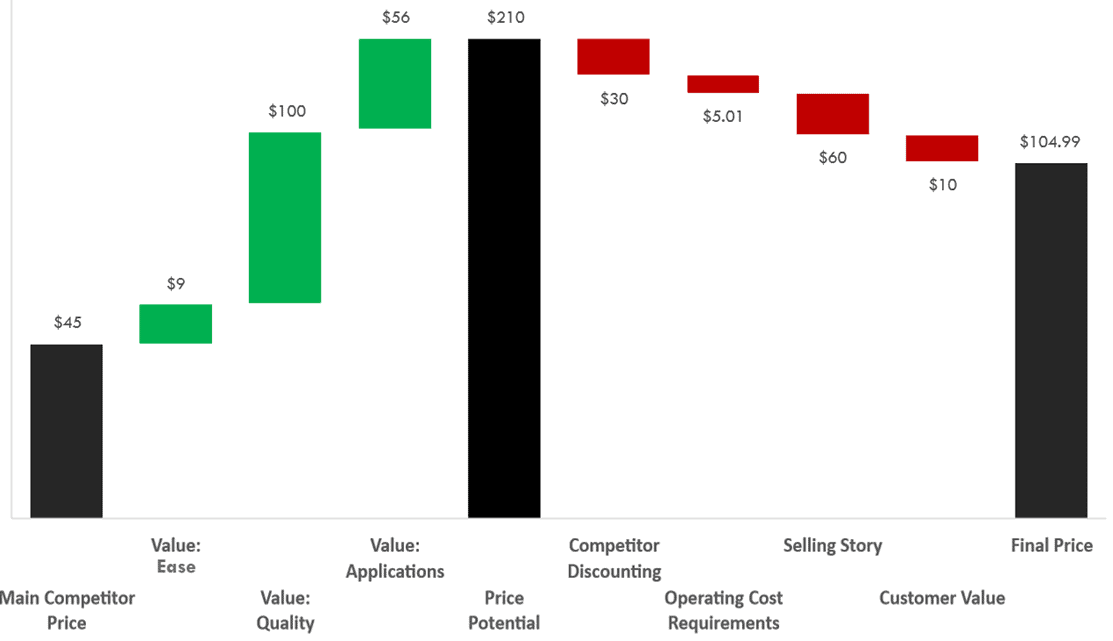
Whether you are a new marketing manager about to launch a product or service, an entrepreneur growing a new venture, or a business leader re-evaluating your company’s existing strategy, pricing is one of the most important things to get right.
NB: This is an article from Revenue Management Labs
Subscribe to our weekly newsletter and stay up to date
No other lever has a higher impact on profits than pricing. In fact, a 1% improvement in price optimization results in an average boost of 8.2% in profits.

Revenue Management Labs, 2021
What Is Value-Based Pricing?
To consumers, price is more than just a number. It is a representation of how much they value what you are selling. For example, if you needed design software, you could use Canva for $61.99/month, or Adobe for $104.99/month. If you were looking for templates, then Canva would win. However, if you wanted to create your own designs, then Adobe wins. The willingness to pay is contingent on the value placed on the product, which depends on hundreds of situational and psychological components. Essentially, value-based pricing is a method of setting prices by identifying and valuing your differentiated features based on a particular customer segment and comparing it with competitors.
Now, let’s dive deeper into the core components of value-based pricing:
1. Focus On One Customer Segment
One of the most important things to remember about value-based pricing is that it should always refer to one specific customer segment (For B2B offerings, it can even be a single customer). Let’s use the earlier example to illustrate this. Adobe’s focus is only on customers who care about making their own designs, not just using templates.
Sales and Marketing teams cannot reap the benefits of value-based pricing unless they target one specific segment. If your organization has multiple customer segments, you must first determine a suitable value-based price for each one. For example, if you segment your target market based on their behavioral and psychographic needs (i.e. price sensitivity, content, quality, etc.), you may end up with 5 unique customer segments that warrant their own offers/prices.

Revenue Management Labs, 2021
2. Compare With The Next Best Alternative
Value-based pricing only works if your one target customer segment has alternative offerings they can buy. That is, there are other competitors in the market vying for your customers. To determine whether there are competitor offerings, ask yourself “What would this segment buy if my product was not available?” The answers you come up with are the next best alternatives and the point of comparison for determining your value-based price. For example, Adobe could view Figma or Sketch as the next best alternatives customers would go to for design capabilities.
Most companies have a list of ~15 competitors, but customers can’t reasonably evaluate all of these. To find your “real” competitors, a mix of sales intuition, customer interviews, external landscape assessment, and win / loss data can help narrow your focus.
3. Understand Differentiated Worth
Before you compare your offerings with the next best alternative, you must first figure out why / how your offerings are unique and differentiated compared to competitors. Doing this will also help you determine which competitors are targeting the same customer segment as you. For example, Apple and IBM are both manufacturing leaders of computer hardware and software. However, Apple’s messaging is focused on creativity while IBM is focused on business functionality. Thus, their target customer segments differ, even though they are in the same market.
4. Determine Your Differentiated Value
The last and probably most difficult step in calculating a value-based price for your offerings is to determine the monetary value of your differentiated features. For example, how much will companies pay for the ability to make their own designs? Once that dollar amount is determined (i.e. $59.99), add that to $45 – Figma’s price. The value-based price of Adobe then becomes $104.99/month. Now, this is a simplified version of the value-based pricing process. There is usually more methodology involved, like transactional analysis and quantitative customer interviews to ensure the price is more accurate and reflective of customer willingness to pay.

Revenue Management Labs, 2021
Note that just because your differentiator is worth $45 does not mean you will get the entire dollar amount. In many cases (i.e. buying or renting a car), there is a negotiation process and you may have to share the value of your differentiating factors with the customer.
Myths About Value-Based Pricing
Value-based pricing is used in almost every industry, pricing everything from cloud-based software to games to websites. While it is one of the most used pricing strategies, it is also one of the most misunderstood. The 3 myths I run into constantly are:
1: “Value-based pricing means evaluating the customer’s willingness to pay for every feature”
Many organizations think that value-based pricing requires setting a price for every single feature. This myth turns many organizations away from value-based pricing and towards simple (but ineffective) pricing strategies like cost-plus.
Thankfully, common features are already priced-in. For example, both Adobe and Figma can crop photos and add image filters. There is no need for Adobe to calculate these features separately because it is already captured in Figma’s $45 price point. The only thing Adobe must do is find the value of their differentiators and assess the customer’s willingness to pay for them. Much easier than pricing everything right?
2: “Value-based pricing will always work, regardless of how competitors’ price”
This myth is probably one of the most dangerous ones out there because it creates high (and false) expectations for value-based pricing. Value-based pricing always works, but it might not give you the answer you want.
The success of value-based pricing depends heavily on how smart your competitors price their offerings. Since value is in the eye of the customer, how competitors price will change how the customer views the market. For example, if competitors unknowingly set their prices too low, customers may de-value the market to the point where you need to make an exit. If you cannot leave, then you may need to force value appreciation to command a higher price. On the flip side, if competitors set their prices higher, it sets a new benchmark for the other companies, giving them room to increase their prices. Thus, value-based pricing won’t guarantee you a windfall of cash, but it will help you make strategic decisions.
3: “The brand’s value is not included in the value-based pricing calculations”
Many organizations believe that only tangible factors can be used in the value-based pricing calculation. As such, they exclude intangible factors like brand value, believing it will generate a more accurate price. This is far from true. In fact, by excluding brand value, the final prices tend to be way off the mark.
Pricing should always reflect a company’s perceived consumer value – a function of Brand, Service, Quality, and Price. The hard part is quantifying how consumers perceive your product and its differentiators compared to the competition. I recommend using external research such as conjoint analysis, transaction analysis, or landscape analysis to accurately quantify your perceived value, as internal conceptions can significantly skew results.
Final Thoughts
Value-based pricing is the most effective pricing strategy and much easier to implement than theory would suggest. I hope this article gave you a better understanding of how value-based pricing works and that you will make smarter pricing decisions in the future to increase profits.




